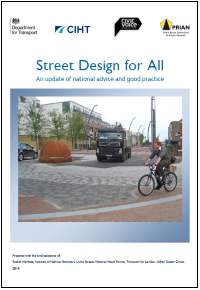 The IHBC has welcomed the Civic Voice-led coalition encouraging the reduction of street clutter.
The IHBC has welcomed the Civic Voice-led coalition encouraging the reduction of street clutter.
David McDonald, IHBC Education Secretary says, ‘I am very pleased to see that Civic Voice is taking up this rather unfashionable issue. The pioneering work by Kensington and Chelsea Council to de-clutter Kensington High Street was much acclaimed, but since then the issue has been rather forgotten. This initiative should bring its value to local authorities and encourage conservation officers and traffic planners to work together to enhance the public realm of our villages, towns and cities.’
The Civic Voice writes:
A powerful coalition of civic, transport and heritage bodies has launched updated guidance at a Parliamentary event by calling on the Government to consider conducting research into the safety impact of cutting street clutter in our towns, cities and villages.
Dr Freddie Gick, Chair of Civic Voice said “Our members are informing us that many local councils are citing safety regulations as the reason for cluttering up our streets. Common sense tells us uncluttered streets have a fresher, freer authentic feel, which are safer and easier to maintain. Street Design for All is updated guidance for anyone with an interest in seeing our towns and cities become more attractive and distinctive.”
Street Design for All explains that in Poynton, Cheshire ten sets of traffic signals were removed and replaced with a high efficiency free-flow junction and carefully designed approaches. The East Cheshire highway authority’s two year road safety records are recently available and show a substantial reduction in casualties, while vehicle flows have been maintained, congestion controlled, street quality considerably improved and businesses regenerated.
The statistics chime with the results of similar schemes, including the de-cluttering of Kensington & Chelsea’s High Street which saw a 40% reduction in road traffic accidents and a 60% reduction in pedestrian accidents. As a coalition we are calling on the Government to consider research and examine this further.
Andrew Hugill, CIHT said: “We believe that through guidance such as this we can encourage local authorities and other stakeholders to work with communities to highlight the benefits of investment in street design. We are working with the Department for Transport to promote good practice in traffic signing through a ‘Reducing Sign Clutter Award’ which will open for entry in the New Year”
The coalition believes:
- The economic well-being of a city, town or village can depend significantly on the appearance of its streets and public space
- Most people value our historic environment, and, in particular appreciate buildings such as cathedral, castles and palaces
- Protecting and promoting local distinctiveness and character and our heritage, respecting and making best use of historic buildings, street forms and settlement patterns.
- Enhancing civic involvement to identify redundant clutter can improve the health of communities
Colin Davis, CEO of PRIAN, finished by saying: ‘The book is intended to help local civic societies and community groups have the confidence to work with their highway authority to make a real difference to their own streets”.
Copies of the report can be accessed from Civic Voice at info@civicvoice.org.uk
Street Design for All is a document produced by Department for Transport, Chartered Institution of Highways & Transportation, Civic Voice and Public Realm Information and Advice Network. It was prepared with the kind assistance of: English Heritage, Institute of Highway Engineers, Living Streets, National Heart Forum, Transport for London, Urban Design Group.
For further information see http://www.civicvoice.org.uk

